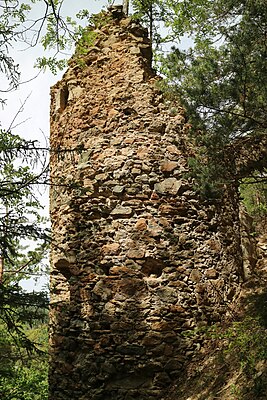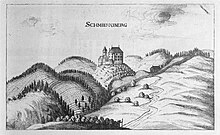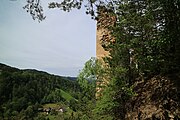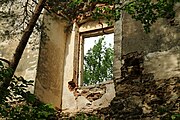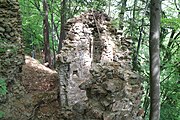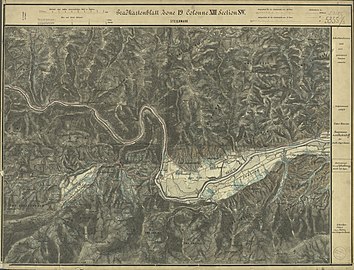Schmirnberg castle ruins
| Schmirnberg castle ruins | ||
|---|---|---|
| Creation time : | before 1100 | |
| Castle type : | Hilltop castle | |
| Conservation status: | ruin | |
| Standing position : | Dukes | |
| Place: | Schlossberg | |
| Geographical location | 46 ° 37 ′ 55 ″ N , 15 ° 29 ′ 15 ″ E | |
| Height: | 600 m above sea level A. | |
|
|
||

The castle ruin Schmirnberg ( Schmierenberg , Slov. Žlemberk ) is the ruin of a hilltop castle on a small wooded knoll in a forest area sloping to the north in the former municipality of Schloßberg near the Slovenian border in southern Styria .
history
The castle is first mentioned around 1250 as castrum Smilnburch owned by a Hadmar von Schönberch, but was probably built by the Spanheimers as early as the 11th century and given as a donation around 1100 to their home monastery, St. Paul . Then the corresponding rule encompassed the whole Leutschacher area (Lords of Liubschach , noble vassals of the pen) and areas west and south of the Poßruck -Hügelkammes direction Drava . The castle also included a Meierhof , which was separated from the rulership at an early stage and subsequently developed into Leutschach and Trautenburg Castle .
St. Paul enfeoffed the Lords of Mureck with the castle , who died out with Reimbert II in 1245. Reimbert's daughter Mechthild brought the castle and the rule to her husband Hadmar von Schönberg, who in 1250 certified the repentant return of estranged goods to the diocese of Seckau . In 1255 his widow Mechthild compensated the St. Paul Abbey for the misery suffered by Hadmar.
Around 1282 the Schönbergers sold Schmirnberg to Count Ulrich von Heunburg , whose Burgrave Marquard (Merchel) von Smielenburg often appears in documents until around 1300. A few years later the castle apparently served as a dowry guarantee for Ulrich's daughter Elisabeth, whose first husband Count Hermann von Pfannberg died in 1287.
In 1292 Count Ulrich played a leading role in the Styrian uprising against Duke Albrecht I ; Schmierenberg was captured by the ducal troops and returned in 1295. On June 22, 1297 zu Traberg, Elisabeth, widow of Count Hermann von Pfannberg, approved a Hube zu Chazfeldesdorf (today Kitzelsdorf) and one to Lodeine (Lateindorf, both near Oberhaag ) with all mining rights according to Eywanswalder ( Eibiswald ) Maß - fiefdom of Marquard von Smielenberg coming from the Counts of Pfannberg - may be given to the Mahrenberg monastery for Marquard's daughter Diemut, a nun there.
1303 we find Elisabeth with her second husband Heinrich von Hohenlohe living on Schmirnberg, where they signed a deed in March for the benefit of the St. Paul Abbey. And even in 1322, when the male Heunburger became extinct, Schmirnberg remained in their possession - along with Traberg and some Upper Styrian Gülten.
However, represented by Heinrich's brother Count Friedrich von Hohenlohe , at that time canon of Bamberg, they sold “Smyelenburch” on June 21, 1326 for 3,000 marks of silver to Ulrich I von Walsee ; his sons Ulrich and Friedrich shared the possessions around the castle in 1352; after their death Schmirnberg came to Eberhard VIII von Walsee († 1363).
In 1363 St. Paul gave Schmirnberg to Duke Rudolf IV , after his death in 1365 to the Counts of Cilli .
King Friedrich III. Schmirnberg snatched the castle from the Cilliern in 1443 - his follower Pankraz von Rindscheid got the castle "for his services from his youth" - and made it into a lordship and lien lordship with regional court and blood jurisdiction in 1445. In 1458 Leutschach became independent as a market and left Schmirnberg's direct administration and jurisdiction.
From the year 1575 there is a directory of the “Merung and Staerung” of the subjects on the occasion of the reform in 1575 (with “Directory of the free donors and merchants ...”) . In 1575 new vaults were built on which two granaries were built, and in 1577 the four-story old floor with a large hall on the fourth floor was rebuilt.
In 1596 the castle appears as a chalk fire warning station in the defense against the Turkish threat.
Until 1621 (sold by Emperor Ferdinand II ) the castle remained in sovereign possession. In the 17th century it was owned by the Stubenberg family and from 1720 to 1912 by the Schönborn family.
The church was still in use at the beginning of the 19th century, since then the extensive, once heavily fortified complex has fallen into ruin. Remains can still be seen of the walls, which were up to 2.5 m thick.
In the northeast of the ruin are the remains of a chapel with the patronage of the Annunciation . This church was first mentioned in a document in 1352.
Name variations
Smyelburch, Smilburch, Smiellnburch, Schmielnberg, Schmielenberg, Smielleberg, Smiellnberg, Schmiernberg, Schmierenberg
neighbours
The neighbors of Schmirnberg were the gentlemen Faal (Fala), Wildhaus (Viltus, both in the Drautal), Trautenburg , Arnfels , Witschein (Svečina), Rabenstein? (near St. Paul), Ehrenhausen , Strasbourg , Marburg ( Maribor )
Other castle owners
(or owner of parts of the estate, without guarantee):
- Policarp Scheidt (from 1621)
- from Herberstein (1667)
- Proßkhau (1667)
- Vedl (1667)
- of Wagensberg (1668)
- Fehr of Fehrntal (1668)
- Count Lengheim (1669)
- Stubenberger (until 1670)
- von Grattenau (around 1671)
- Katzians (1671/72)
- from Schölling (1673)
- Breuner (until 1677)
- Peter Philipp von Dernbach (1619–1683), Bishop of Bamberg and Würzburg (Dernbacher / Dernpacher until after 1686)
- from Schönborn (after 1686)
- Stubenberger (around 1693)
- Khißl (1705)
- from Jabornegg and Gamsenegg (until 1724)
- by Schönborn (from 1724)
- Count Discounta (1734)
- by Gaisruck (1791)
- Hit ()
- Ursini-Rosenberg ()
Bailiwicks
- Leutschach parish church
- Church of St. Pankratius ob der Lieschen (St. Pongratzen)
- Filial church of the Holy Spirit (Heiligengeist am Osterberg, Sveti Duh na Ostrem vrhu)
Arable
The following land registers are recorded in the land register:
- Leutschach market
- Office Großwalz
- Office of Kleinwalz
- Castle Office
- Reifnig (Ribnica na Pohorju, Reifing am Bachern)
- Saldenhofen (Vuzenica)
- Gatschenthal (Gačnik)
- photos
- Historical maps
Schmirnberg ruins near Schlossberg, in the area of Grosswalz im Possruck (bottom center right): Record sheet of the 3rd regional survey 1: 25,000
literature
- Werner Murgg: Castle ruins in Styria . In: Find reports from Austria, material booklets, series B, volume 2 . Published by the Federal Monuments Office, Department for Ground Monuments, Verlag Ferdinant Berger and Sons, Vienna 2009, pp. 86–87.
- Robert Baravalle: Styrian castles and palaces . 1. Volume, Graz 1936, p. 121 ff.
Web links
Individual evidence
- ^ A b c d Kurt Woisetschläger, Peter Krenn: Dehio Handbook - The art monuments of Austria: Styria (excluding Graz). Topographical inventory of monuments, ed. from the Federal Monuments Office, Department for Monument Research. Publisher Anton Schroll. Vienna 1982. ISBN 3-7031-0532-1 . Page 502–503.
